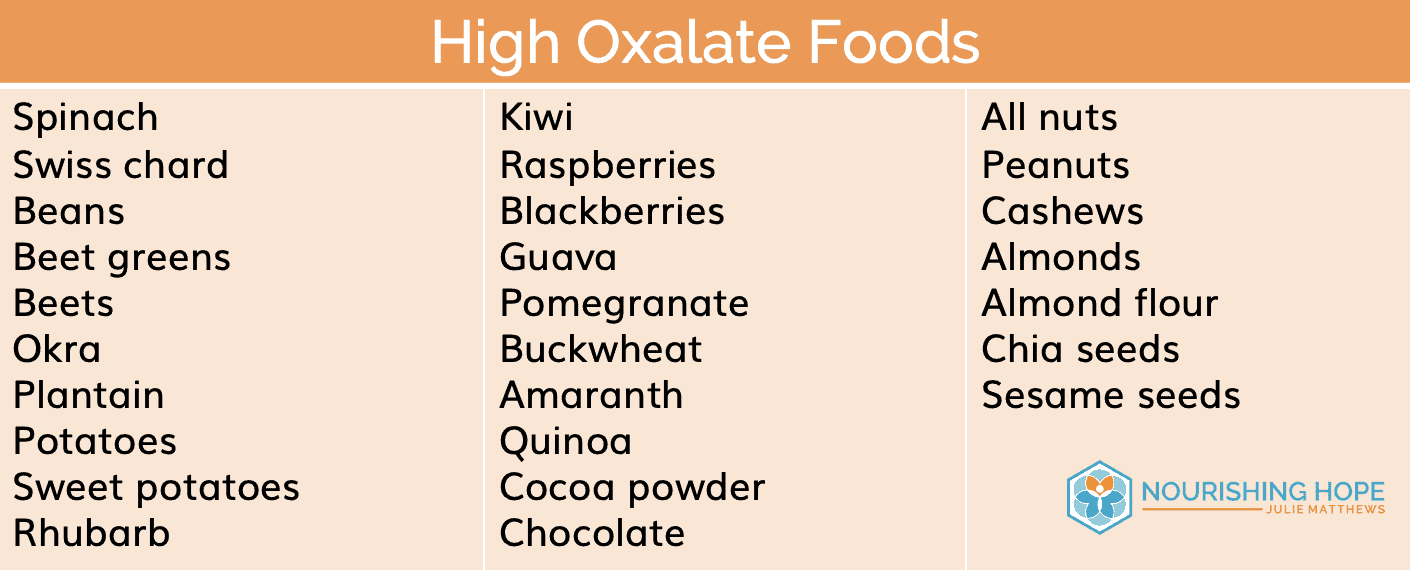Low Oxalate Diet
Oxalates
Oxalates are molecules found in plants that have a number of functions for the plant including deterring bugs from eating them (since they kill the insect).
As such, oxalates are found in plant foods such as nuts, leafy greens, rhubarb, legumes, chocolate, and more.
Oxalate binds to minerals such as calcium, magnesium, zinc, and iron.
Negative Effects of Oxalates
Since they bind to minerals, many plants very high in calcium such as spinach, almonds, and sesame seeds tend to be very high in oxalate. Unfortunately for humans this makes oxalate an antinutrient, as we are not able to absorb and utilize the calcium because of the oxalate.
And while they are an antinutrient for everyone, some people have more difficulty with oxalate than others. High levels of oxalate in the body can be a problem. Oxalates can lead to nutrient deficiency, and they can be deposited throughout the body causing inflammation, oxidative stress, and pain.
Oxalates are most known for their role in creating kidney stones, however, the latest scientific research shows us even people without kidney stones can have problems with oxalates. Researchers found high oxalate levels in the individuals with autism, all who had normal kidney function.
Interestingly, oxalates can impair mitochondrial function causing extreme fatigue. Oxalates can also trigger the inflammasome, as is the case in autoimmune conditions causing ongoing inflammation, oxidative stress, and pain.
Oxalates have been linked to:
- Inflammation and pain
- Digestive system issues
- Microbiome imbalance / dysbiosis
- Slow growth in children
- Fatigue
- Brain fog
- Autoimmune disorders
- Many chronic diseases
- Autism
There are many reasons for high oxalates in the body. One of these is a diet high in oxalate. Normally, your gut microbiome breaks down oxalate, but oxalate can also harm your gut bacteria– and an imbalance in your gut bacteria and digestive disorders can lead to higher oxalate levels. Additionally, digestion of fats, vitamin and mineral levels, and individual biochemistry all affect oxalate levels.
Low Oxalate Diet
I have heard amazing case studies from clients and nutrition colleagues that implement the low oxalate diet, and found wonderful improvement when this diet is needed.
The low oxalate diet restricts high oxalate foods, usually reduced slowly over time. If you are considering a low oxalate diet, research oxalates, plan your approach before beginning, and go slowly. It’s important not to remove oxalates too quickly.
Foods high in oxalate include: Spinach, swiss chard, beet greens, beets, sweet potatoes, potatoes, rhubarb, nuts, some seeds, legumes, certain grains, some fruits, and chocolate.

Also, in addition to diet, oxalates can be high because they can be produced inside the body (endogenously), particularly when there are nutrient deficiencies. So in addition to a low oxalate diet, other oxalate factors should be considered such as adequate levels of vitamins such as B6, avoidance of certain supplements and foods that can convert to oxalate including vitamin C.
The low oxalate diet can let many children and adults with a variety of neurological, digestive, and immune conditions based on their biochemistry and personalized nutrition needs.
I teach parents and individuals in my Nourishing Hope for Healing Kids program and practitioners in my BioIndividual Nutrition Training that after relieving the burden on the body of these foods with a low oxalate diet, we can work on addressing any other dietary and nutritional needs.
You can learn more about these and other special therapeutic diets here. And you can find Low Oxalate recipes I have created here.
